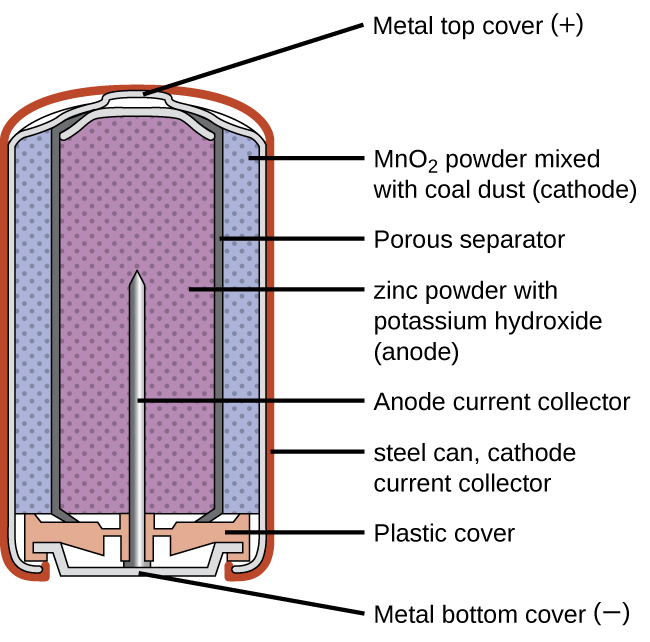A common primary battery is the dry cell, which uses a zinc can as both container and anode (“–” terminal) and a graphite rod as the cathode (“+” terminal). The Zn can is filled with an electrolyte paste containing manganese(IV) oxide, zinc(II) chloride, ammonium chloride, and water. A graphite rod is immersed in the electrolyte paste to complete the cell. The spontaneous cell reaction involves the oxidation of zinc:
$$\text{anode reaction: }Zn(s) ⟶ Zn^{2+}(aq) + 2e^−$$and the reduction of manganese(IV)
$$\text{reduction reaction: } 2MnO_2(s) + 2NH_4Cl(aq) + 2e^− ⟶ Mn_2O_3(s) + 2NH_3(aq) + H_2O(l) + 2Cl^−$$which together yield the cell reaction:
$$\text{cell reaction: }2MnO_2(s) + 2NH_4Cl(aq) + Zn(s) ⟶ Zn^{2+}(aq) + Mn_2O_3(s) + 2NH_3(aq) + H_2O(l)+2Cl^−\quad E_{cell}~1.5V$$The voltage (cell potential) of a dry cell is approximately 1.5 V. Dry cells are available in various sizes (e.g., D, C, AA, AAA). All sizes of dry cells comprise the same components, and so they exhibit the same voltage, but larger cells contain greater amounts of the redox reactants and therefore are capable of transferring correspondingly greater amounts of charge. Like other galvanic cells, dry cells may be connected in series to yield batteries with greater voltage outputs, if needed.

Watch this video to learn more about zinc-carbon batteries.
Alkaline batteries were developed in the 1950s to improve on the performance of the dry cell, and they were designed around the same redox couples. As their name suggests, these types of batteries use alkaline electrolytes, often potassium hydroxide. The reactions are
anode: Zn(s) + 2OH−(aq) ⟶ ZnO(s) + H2O(l) + 2e−
cathode: 2MnO2(s) + H2O(l) + 2e− ⟶ Mn2O3(s) + 2OH−(aq)
cell: Zn(s) + 2MnO2(s) ⟶ ZnO(s) + Mn2O3(s) Ecell=+1.43 V
An alkaline battery can deliver about three to five times the energy of a zinc-carbon dry cell of similar size. Alkaline batteries are prone to leaking potassium hydroxide, so they should be removed from devices for long-term storage. While some alkaline batteries are rechargeable, most are not. Attempts to recharge an alkaline battery that is not rechargeable often leads to rupture of the battery and leakage of the potassium hydroxide electrolyte.

Visit this site to learn more about alkaline batteries.